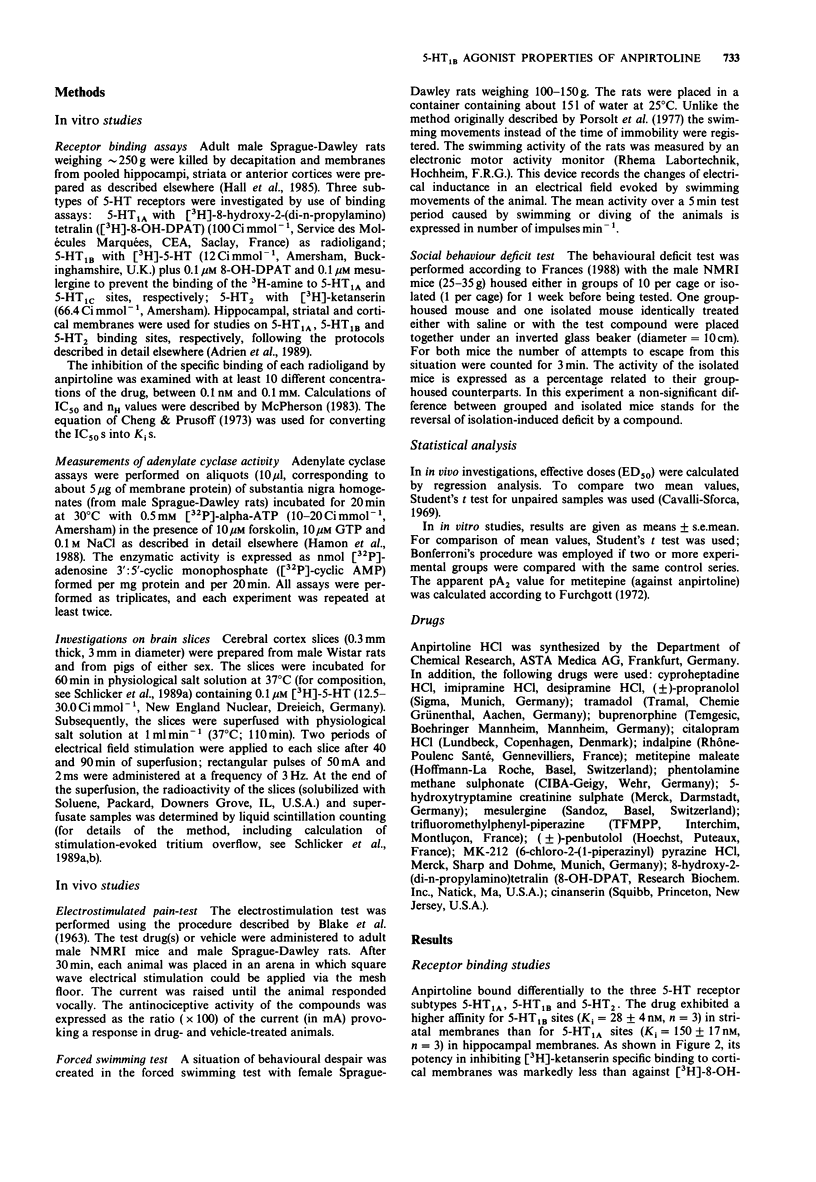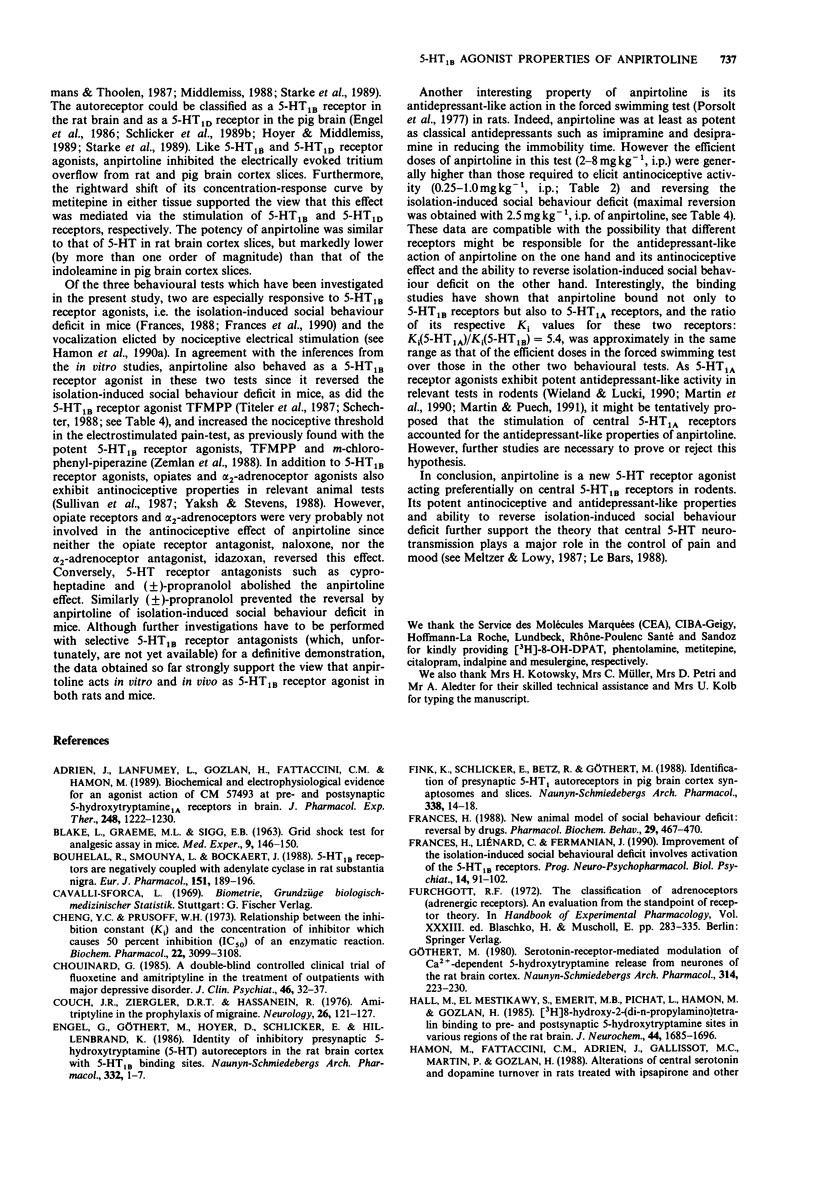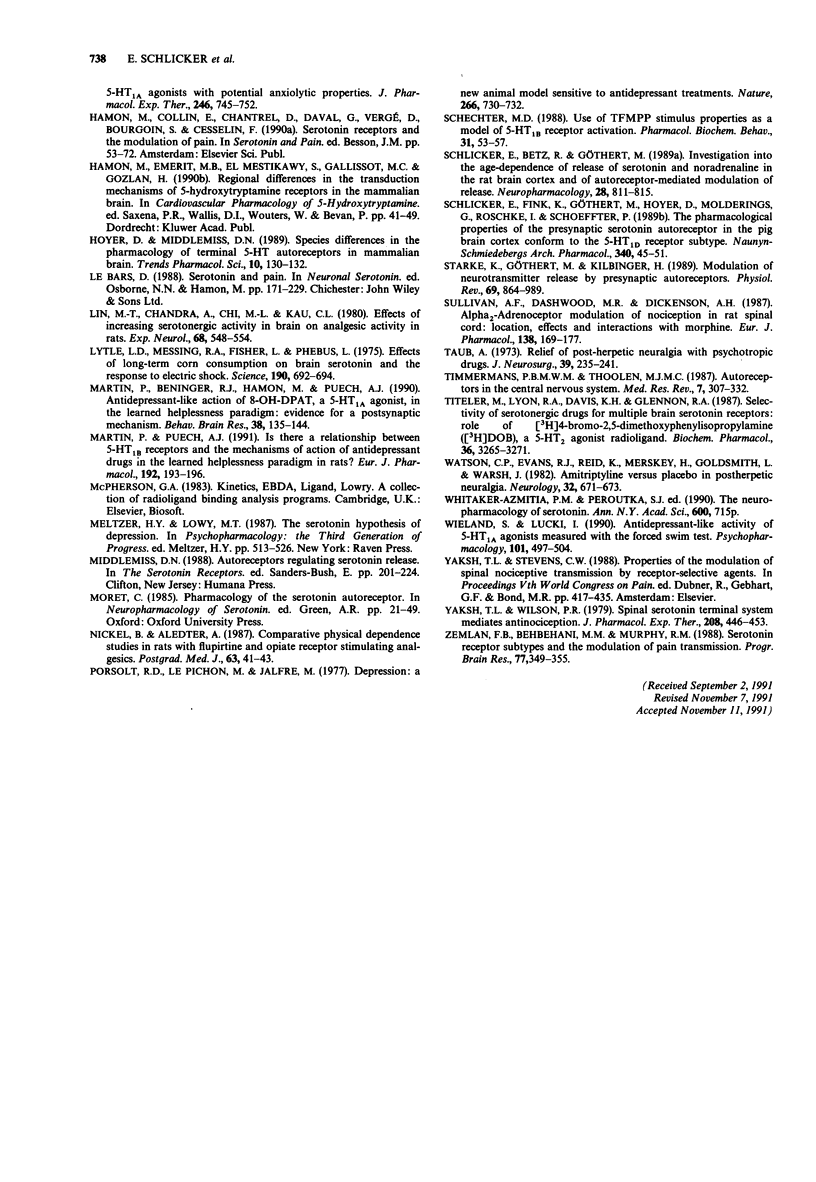Abstract
1. The purpose of the present study was to relate the effects of the novel drug, anpirtoline, on 5-hydroxytryptamine (5-HT) receptor subtypes to its antinociceptive and antidepressant-like actions in rodents. 2. Binding assays with rat brain membranes have shown that anpirtoline bound with a much higher affinity to 5-HT1B receptor (Ki = 28 nM) than to 5-HT1A (Ki = 150 nM) and 5-HT2 (Ki = 1.49 microM) receptors. 3. Like 5-HT, anpirtoline concentration-dependently inhibited forskolin-stimulated adenylate cyclase activity in homogenates from the rat substantia nigra. Both effects were not additive, and could be prevented by 5-HT1B receptor antagonists such as propranolol and penbutolol. 4. In superfused rat and pig brain cortex slices preincubated with [3H]-5-HT, the electrically evoked tritium overflow was inhibited by anpirtoline and 5-HT. Whereas 5-HT was equipotent in both tissues (EC50 = 69 nM), anpirtoline was markedly less potent in pig brain cortex slices (EC50 = 1190 nM) than in rat brain cortex slices (EC50 = 55 nM). The concentration-response curve for anpirtoline was shifted to the right by metitepine in both preparations. 5. In the social behaviour deficit test, anpirtoline and trifluoromethylphenyl-piperazine were effective in reversing the isolation-induced impairments in mice, an effect shown only by compounds with agonist properties at the 5-HT1B receptor. 6. In the electrostimulated pain test using mice, anpirtoline dose-dependently increased the pain threshold with an ED50 of 0.52 mg kg-1, i.p. The antinociceptive activity of anpirtoline was abolished by pretreatment with cyproheptadine or propranolol.(ABSTRACT TRUNCATED AT 250 WORDS)
Full text
PDF






Selected References
These references are in PubMed. This may not be the complete list of references from this article.
- Adrien J., Lanfumey L., Gozlan H., Fattaccini C. M., Hamon M. Biochemical and electrophysiological evidence for an agonist action of CM 57493 at pre- and postsynaptic 5-hydroxytryptamine1A receptors in brain. J Pharmacol Exp Ther. 1989 Mar;248(3):1222–1230. [PubMed] [Google Scholar]
- BLAKE L., GRAEME M. L., SIGG E. B. GRID SHOCK TEST FOR ANALGESIC ASSAY IN MICE. Med Exp Int J Exp Med. 1963;9:146–150. doi: 10.1159/000135345. [DOI] [PubMed] [Google Scholar]
- Bouhelal R., Smounya L., Bockaert J. 5-HT1B receptors are negatively coupled with adenylate cyclase in rat substantia nigra. Eur J Pharmacol. 1988 Jul 7;151(2):189–196. doi: 10.1016/0014-2999(88)90799-6. [DOI] [PubMed] [Google Scholar]
- Cheng Y., Prusoff W. H. Relationship between the inhibition constant (K1) and the concentration of inhibitor which causes 50 per cent inhibition (I50) of an enzymatic reaction. Biochem Pharmacol. 1973 Dec 1;22(23):3099–3108. doi: 10.1016/0006-2952(73)90196-2. [DOI] [PubMed] [Google Scholar]
- Chouinard G. A double-blind controlled clinical trial of fluoxetine and amitriptyline in the treatment of outpatients with major depressive disorder. J Clin Psychiatry. 1985 Mar;46(3 Pt 2):32–37. [PubMed] [Google Scholar]
- Couch J. R., Ziegler D. K., Hassanein R. Amitriptyline in the prophylaxis of migraine. Effectiveness and relationship of antimigraine and antidepressant effects. Neurology. 1976 Feb;26(2):121–127. doi: 10.1212/wnl.26.2.121. [DOI] [PubMed] [Google Scholar]
- Engel G., Göthert M., Hoyer D., Schlicker E., Hillenbrand K. Identity of inhibitory presynaptic 5-hydroxytryptamine (5-HT) autoreceptors in the rat brain cortex with 5-HT1B binding sites. Naunyn Schmiedebergs Arch Pharmacol. 1986 Jan;332(1):1–7. doi: 10.1007/BF00633189. [DOI] [PubMed] [Google Scholar]
- Fink K., Schlicker E., Betz R., Göthert M. Identification of presynaptic 5-HT1 autoreceptors in pig brain cortex synaptosomes and slices. Naunyn Schmiedebergs Arch Pharmacol. 1988 Jul;338(1):14–18. doi: 10.1007/BF00168806. [DOI] [PubMed] [Google Scholar]
- Frances H., Lienard C., Fermanian J. Improvement of the isolation-induced social behavioural deficit involves activation of the 5-HT1B receptors. Prog Neuropsychopharmacol Biol Psychiatry. 1990;14(1):91–102. doi: 10.1016/0278-5846(90)90067-q. [DOI] [PubMed] [Google Scholar]
- Francès H. New animal model of social behavioral deficit: reversal by drugs. Pharmacol Biochem Behav. 1988 Mar;29(3):467–470. doi: 10.1016/0091-3057(88)90005-6. [DOI] [PubMed] [Google Scholar]
- Göthert M. Serotonin-receptor-mediated modulation of Ca2+-dependent 5-hydroxytryptamine release from neurones of the rat brain cortex. Naunyn Schmiedebergs Arch Pharmacol. 1980 Nov;314(3):223–230. doi: 10.1007/BF00498543. [DOI] [PubMed] [Google Scholar]
- Hall M. D., el Mestikawy S., Emerit M. B., Pichat L., Hamon M., Gozlan H. [3H]8-hydroxy-2-(di-n-propylamino)tetralin binding to pre- and postsynaptic 5-hydroxytryptamine sites in various regions of the rat brain. J Neurochem. 1985 Jun;44(6):1685–1696. doi: 10.1111/j.1471-4159.1985.tb07155.x. [DOI] [PubMed] [Google Scholar]
- Hamon M., Fattaccini C. M., Adrien J., Gallissot M. C., Martin P., Gozlan H. Alterations of central serotonin and dopamine turnover in rats treated with ipsapirone and other 5-hydroxytryptamine1A agonists with potential anxiolytic properties. J Pharmacol Exp Ther. 1988 Aug;246(2):745–752. [PubMed] [Google Scholar]
- Hoyer D., Middlemiss D. N. Species differences in the pharmacology of terminal 5-HT autoreceptors in mammalian brain. Trends Pharmacol Sci. 1989 Apr;10(4):130–132. doi: 10.1016/0165-6147(89)90159-4. [DOI] [PubMed] [Google Scholar]
- Lin M. T., Chandra A., Chi M. L., Kau C. L. Effects of increasing serotonergic receptor activity in brain on analgesic activity in rats. Exp Neurol. 1980 Jun;68(3):548–554. doi: 10.1016/0014-4886(80)90108-9. [DOI] [PubMed] [Google Scholar]
- Lytle L. D., Messing R. B., Fisher L., Phebus L. Effects of long-term corn consumption on brain serotonin and the response to electric shock. Science. 1975 Nov 14;190(4215):692–694. doi: 10.1126/science.810890. [DOI] [PubMed] [Google Scholar]
- Martin P., Beninger R. J., Hamon M., Puech A. J. Antidepressant-like action of 8-OH-DPAT, a 5-HT1A agonist, in the learned helplessness paradigm: evidence for a postsynaptic mechanism. Behav Brain Res. 1990 May 7;38(2):135–144. doi: 10.1016/0166-4328(90)90011-3. [DOI] [PubMed] [Google Scholar]
- Martin P., Puech A. J. Is there a relationship between 5-HT1B receptors and the mechanisms of action of antidepressant drugs in the learned helplessness paradigm in rats? Eur J Pharmacol. 1991 Jan 3;192(1):193–196. doi: 10.1016/0014-2999(91)90091-4. [DOI] [PubMed] [Google Scholar]
- Nickel B., Aledter A. Comparative physical dependence studies in rats with flupirtine and opiate receptor stimulating analgesics. Postgrad Med J. 1987;63 (Suppl 3):41–43. [PubMed] [Google Scholar]
- Porsolt R. D., Le Pichon M., Jalfre M. Depression: a new animal model sensitive to antidepressant treatments. Nature. 1977 Apr 21;266(5604):730–732. doi: 10.1038/266730a0. [DOI] [PubMed] [Google Scholar]
- Schechter M. D. Use of TFMPP stimulus properties as a model of 5-HT1B receptor activation. Pharmacol Biochem Behav. 1988 Sep;31(1):53–57. doi: 10.1016/0091-3057(88)90310-3. [DOI] [PubMed] [Google Scholar]
- Schlicker E., Betz R., Göthert M. Investigation into the age-dependence of release of serotonin and noradrenaline in the rat brain cortex and of autoreceptor-mediated modulation of release. Neuropharmacology. 1989 Aug;28(8):811–815. doi: 10.1016/0028-3908(89)90172-x. [DOI] [PubMed] [Google Scholar]
- Schlicker E., Fink K., Göthert M., Hoyer D., Molderings G., Roschke I., Schoeffter P. The pharmacological properties of the presynaptic serotonin autoreceptor in the pig brain cortex conform to the 5-HT1D receptor subtype. Naunyn Schmiedebergs Arch Pharmacol. 1989 Jul;340(1):45–51. doi: 10.1007/BF00169206. [DOI] [PubMed] [Google Scholar]
- Starke K., Göthert M., Kilbinger H. Modulation of neurotransmitter release by presynaptic autoreceptors. Physiol Rev. 1989 Jul;69(3):864–989. doi: 10.1152/physrev.1989.69.3.864. [DOI] [PubMed] [Google Scholar]
- Sullivan A. F., Dashwood M. R., Dickenson A. H. Alpha 2-adrenoceptor modulation of nociception in rat spinal cord: location, effects and interactions with morphine. Eur J Pharmacol. 1987 Jun 19;138(2):169–177. doi: 10.1016/0014-2999(87)90430-4. [DOI] [PubMed] [Google Scholar]
- Taub A. Relief of postherpetic neuralgia with psychotropic drugs. J Neurosurg. 1973 Aug;39(2):235–239. doi: 10.3171/jns.1973.39.2.0235. [DOI] [PubMed] [Google Scholar]
- Timmermans P. B., Thoolen M. J. Autoreceptors in the central nervous system. Med Res Rev. 1987 Jul-Sep;7(3):307–332. doi: 10.1002/med.2610070303. [DOI] [PubMed] [Google Scholar]
- Titeler M., Lyon R. A., Davis K. H., Glennon R. A. Selectivity of serotonergic drugs for multiple brain serotonin receptors. Role of [3H]-4-bromo-2,5-dimethoxyphenylisopropylamine ([3H]DOB), a 5-HT2 agonist radioligand. Biochem Pharmacol. 1987 Oct 1;36(19):3265–3271. doi: 10.1016/0006-2952(87)90643-5. [DOI] [PubMed] [Google Scholar]
- Watson C. P., Evans R. J., Reed K., Merskey H., Goldsmith L., Warsh J. Amitriptyline versus placebo in postherpetic neuralgia. Neurology. 1982 Jun;32(6):671–673. doi: 10.1212/wnl.32.6.671. [DOI] [PubMed] [Google Scholar]
- Wieland S., Lucki I. Antidepressant-like activity of 5-HT1A agonists measured with the forced swim test. Psychopharmacology (Berl) 1990;101(4):497–504. doi: 10.1007/BF02244228. [DOI] [PubMed] [Google Scholar]
- Yaksh T. L., Wilson P. R. Spinal serotonin terminal system mediates antinociception. J Pharmacol Exp Ther. 1979 Mar;208(3):446–453. [PubMed] [Google Scholar]
- Zemlan F. P., Behbehani M. M., Murphy R. M. Serotonin receptor subtypes and the modulation of pain transmission. Prog Brain Res. 1988;77:349–355. doi: 10.1016/s0079-6123(08)62801-0. [DOI] [PubMed] [Google Scholar]


